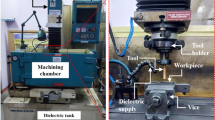Abstract
Additive manufacturing is considered more sustainable than traditional manufacturing due to its efficient energy and materials usage. However, previous literature indicates that this suggestion is applicable only for the polymer materials, and the environmental issues of additive manufacturing with metallic materials are still not clear. With the method of life cycle assessment, this paper analyzes and compares the energy consumptions and environmental impacts of direct energy deposition and traditional machining processes for a typical metal part. Further, the article attempts to identify the significant issues in the two manufacturing options that contribute most to the environmental impacts. Six environmental impacts were assessed in this study: global warming potential (GWP); acidification potential (AP); eutrophication potential; ozone depletion potential (ODP); photochemical ozone creation potential (POCP); and abiotic depletion potential (ADP). The results show that the gear laser fabrication process consumes more energy and releases more negative emissions compared with traditional gear manufacturing processes. The results of GWP, AP, ODP, ADP and POCP of the traditional gear manufacturing are only 30.33, 43.42, 17, 65.05 and 54.68% of the gear laser fabrication.







Similar content being viewed by others
References
Basket JS, Lacke CJ, Weizt KA, Warren JL (1995) Guidelines for assessing the quality of life cycle inventory analysis. EPA (NTIS)
Burkhart M, Aurich JC (2015) Framework to predict the environmental impact of additive manufacturing in the life cycle of a commercial vehicle. Procedia CIRP 29:408–413
Campbell TA, Williams CB, Ivanova O, Garrett B (2011) Could 3D printing change the world? Technologies, potential and implications of additive manufacturing, strategic foresight. Atlantic Council (www.acus.org)
Das S, Beama JJ, Wohlert M, Bourell DL (1998) Direct laser freeform fabrication of high performance metal components. Rapid Prototyp J 4(3):112–117
Dong S, Yan S, Xu B, Wang Y, Ren W (2013) Laser cladding remanufacturing technology of cast iron cylinder head and its quality evaluation. J Acad Armored Force Eng 27(1):90–93
Environmental Protection Agency (2006) Life cycle assessment: principles and practice. EPA 600/R-06/060. National Risk Management Research Laboratory, Cincinnati, Ohio, USA
Faludi J, Bayley C, Bhogal S, Iribarne M (2015) Comparing environmental impacts of additive manufacturing vs traditional machining via life-cycle assessment. Rapid Prototyp J 21(1):14–33
Gasser A, Backes G, Kelbassa I, Weisheit A, Wissenbach K (2010) Laser additive manufacturing. Laser Technik J 7(2):58–63
Groen EA, Heijungs R, Bokkers EA, de Boer IJ (2014) Sensitivity analysis in life cycle assessment. In: Proceedings of the 9th international conference on life cycle assessment in the agri-food sector, pp 8–10
Gu DD, Meiners W, Wissenbach K, Poprawe R (2012) Laser additive manufacturing of metallic components: materials, processes and mechanisms. Int Mater Rev 57(3):133–164
Jeantette FP, Keicher DM, Romero JA, Schanwald LP (2000) U.S. Patent, No. 6,046,426. Washington, DC: U.S. Patent and Trademark Office
Jiang Q, Li T, Liu Z, Zhang H, Ren K (2014) Life cycle assessment of an engine with input-output based hybrid analysis method. J Clean Prod 78:131–138
Kate D (2015) Can We 3D Print our Way to Sustainability? Earth island journal. Retrieved from http://www.earthisland.org
Kobryn PA, Semiatin SL (2001) The laser additive manufacture of Ti-6Al-4V. JOM 53(9):40–42
Kurman M, Lipson H (2013) Is eco friendly 3D printing a myth? Triple Helix Innovation and Cornell University. http://www.livescience.com/38323-is-3dprinting-eco-friendly.html
Li T, Liu ZC, Zhang HC, Jiang QH (2013) Environmental emissions and energy consumptions assessment of a diesel engine from the life cycle perspective. J Clean Prod 53:7–12
Liu Z, Li T, Jiang Q, Zhang H (2014) Life cycle assessment–based comparative evaluation of originally manufactured and remanufactured diesel engines. J Ind Ecol 18(4):567–576
Liu Z, Ning F, Cong W, Jiang Q, Li T, Zhang H, Zhou Y (2016) Energy consumption and saving analysis for laser engineered net shaping of metal powders. Energies 9(10):763
Mudge RP, Wald NR (2007) Laser engineered net shaping advances additive manufacturing and repair. Weld J 86(1):44
Murr LE, Gaytan SM, Ramirez DA, Martinez E, Hernandez J, Amato KN, Wicker RB (2012) Metal fabrication by additive manufacturing using laser and electron beam melting technologies. J Mater Sci Technol 28(1):1–14
Paris H, Mokhtarian H, Coatanéa E, Museau M, Ituarte IF (2016) Comparative environmental impacts of additive and subtractive manufacturing technologies. CIRP Ann Manuf Technol 65:29–32
Pei YT, De Hosson JTM (2000) Functionally graded materials produced by laser cladding. Acta Mater 48(10):2617–2624
Rebitzer G, Ekvall T, Frischknecht R, Hunkeler D, Norris G, Rydberg T, Pennington DW (2004) Life cycle assessment: part 1: framework, goal and scope definition, inventory analysis, and applications. Environ Int 30(5):701–720
Reeves P (2009) Additive manufacturing—a supply chain wide response to economic uncertainty and environmental sustainability. Econolyst Limited, the Silversmiths, Crown Yard, Wirksworth, Derbyshire, DE4 4ET, UK
Santos EC, Shiomi M, Osakada K, Laoui T (2006) Rapid manufacturing of metal components by laser forming. Int J Mach Tools Manuf 46(12):1459–1468
Scott J, Gupta N, Weber C, Newsome S, Wohlers T, Caffrey T (2012) Additive manufacturing: status and opportunities. Science and Technology Policy Institute, Washington, pp 1–29
Serres N, Tidu D, Sankare S, Hlawka F (2011) Environmental comparison of MESO-CLAD® process and conventional machining implementing life cycle assessment. J Clean Prod 19(9):1117–1124
Shi J, Li T, Liu Z, Zhang H, Peng S, Jiang Q, Yin J (2015) Life cycle environmental impact evaluation of newly manufactured diesel engine and remanufactured LNG engine. Procedia CIRP 29:402–407
Westkämper E (2000) Life cycle management and assessment: approaches and visions towards sustainable manufacturing (keynote paper). CIRP Ann Manuf Technol 49(2):501–526
Yoon HS, Lee JY, Kim HS, Kim MS, Kim ES, Shin YJ, Chu WS, Ahn SH (2014) A comparison of energy consumption in bulk forming, subtractive, and additive processes: review and case study. Int J Precis Eng Manuf Green Technol 1(3):261–279
Author information
Authors and Affiliations
Corresponding author
Additional information
Editorial responsibility: Agnieszka Galuszka.
Rights and permissions
About this article
Cite this article
Liu, Z., Jiang, Q., Cong, W. et al. Comparative study for environmental performances of traditional manufacturing and directed energy deposition processes. Int. J. Environ. Sci. Technol. 15, 2273–2282 (2018). https://doi.org/10.1007/s13762-017-1622-6
Received:
Revised:
Accepted:
Published:
Issue Date:
DOI: https://doi.org/10.1007/s13762-017-1622-6




